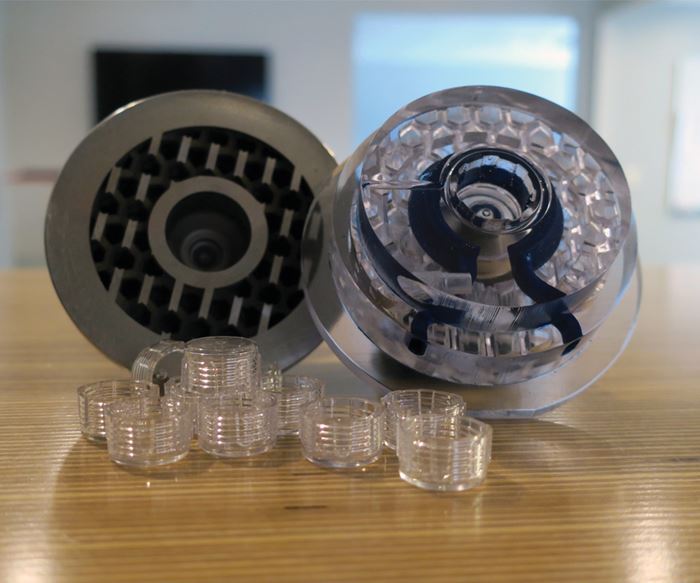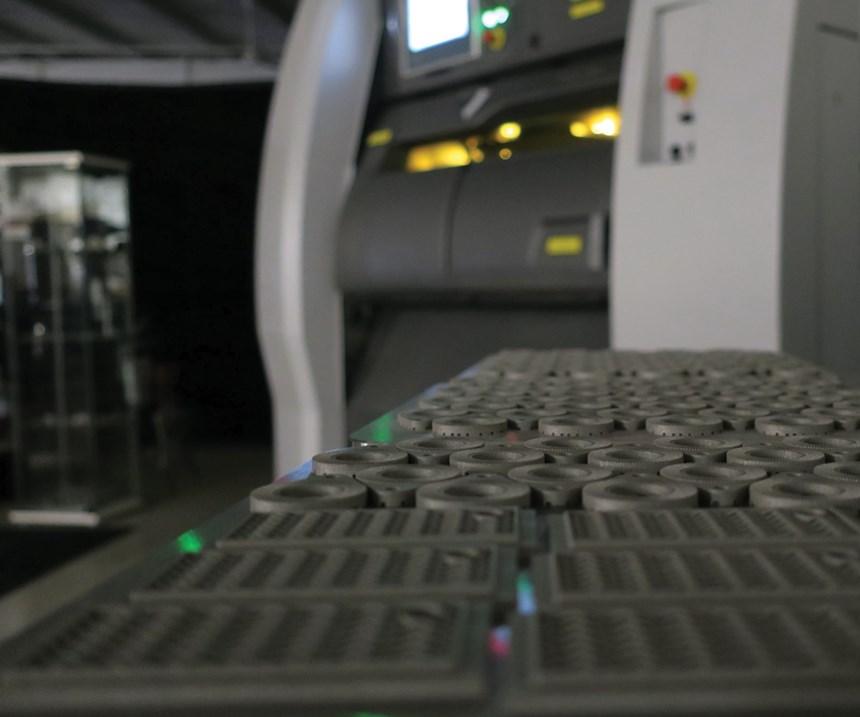Building a Better Tool
Design enhancements for a conformal-cooled insert leverage 3D-printing capabilities.
PIn a project launched with the intent to prove that conformal cooling is not only feasible, but also accessible, Diamond Tool and Engineering produced an injection mold that was designed to push the limits of traditional moldmaking. A direct metal laser-melted conformal-cooled insert was essential to the project’s success.
Diamond Tool is a precision plastic injection mold builder headquartered in Bertha, Minnesota, that specializes in tight-tolerance, multi-cavity tooling for the medical industry. Four years ago, the company built a 600-pound, six-rotation unscrewing mold using a hydraulic cylinder for a medical cap made from a medical-grade polycarbonate resin. The resin required the part to cool completely before unscrewing and for the unscrewing to take place very slowly. The mold design caused inefficient cooling of the runner and part, and a cold runner tunnel gate added 0.046 ounce of material, an 87-percent increase. A 35- to 40-second cycle time was required for this traditionally designed tool, with a round cooling channel around the outside of the cavity block, a hydraulic unscrewing mechanism and a cold runner. This left Diamond Tool engineers wondering how they could battle the complexities of unthreading a polycarbonate part without smearing the threads, and do so quickly.
To beat this time and to build a better tool, Diamond Tool partnered with several technology suppliers to incorporate a dovetail collapsing core and a 3D-printed stainless steel cavity block with conformal cooling. Those partners included Toshiba for the press and processing; 3D Systems 3DXpert software to design the cavity block; 3DPrintedParts.com to print the cavity block; Progressive Components for a wireless CVe monitor, slide locks and other mold components; DME for the mold base; and Mold-Masters for the valve-gate hot drop. Roehr Tool provided a DT dovetail collapsing core for the threaded undercuts (14 mm), which created the inside thread detail, eliminating the need for a slow unscrewing mechanism, hydraulics or other complex actuation.
The Conformal Cooling Key
To build the conformal-cooled injection mold, the company turned to 3DPrintedParts.com. The AM provider located in Grand Rapids, Michigan, approached the project with an eye toward leveraging the capabilities of direct metal laser melting for this specific mold.
“A lot of people approach 3D printing as a speedy process that will replace conventional manufacturing, which isn’t necessarily true. The value isn’t in the process, it is in the products,” says Mike McLean, general manager of 3DPrintedParts.com.
With direct metal printing, 3DPrintedParts.com focuses on printing only the features that add functional value to a part. “A conventionally designed insert would be machined out of billet, and it would be wasteful to cut away material that doesn’t contribute to the final part. With 3D printing, it’s the opposite. It is wasteful to use material that doesn’t contribute to the final part,” McLean says. He calls this a focus on intelligent geometry, which he believes has a two-fold impact: less time under the laser, which reduces the cost of the insert, and less finished mass within the insert, which enhances the thermal management capacity of the conformal cooling channels.
After a 30-minute consultation with Diamond and within days of receiving the CAD data, 3DPrintedParts.com was able to deliver the part with only a negligible extension of a normal tooling lead time. The mold was printed on a 3D Systems ProX300 direct metal printer, chosen for the application “because of its unique roller mechanism that reaches the highest density parts of any direct metal printer,” McLean says. This density ultimately impacts the wearability of the finished insert, which is a critical aspect of a printed part.
The consultation at the beginning of the project led to design enhancements that leveraged the capabilities of the 3D printing process. In addition to the conformal cooling, the design team at 3DPrintedParts.com identified regions of the mold that could be replaced with a lattice structure instead of being printed solid throughout.
McLean says he learned a lot about 3D printing and conformal cooling as a result of working on this project. For example, you can cost-effectively apply conformal cooling to products if you are willing to focus on printing intelligent geometry. This means, to leverage 3D printing economically, you must be willing to change conventional design thinking. The starting point isn’t a solid block of material, so you’re not limited to producing heavy and dense objects, which ultimately drive costs, he says.
He also found that 3D printing is accessible from a cost perspective if the design constraints of the direct metal printing process are anticipated in the final part or insert design. For example:
• Less mass is more savings. To solidify parts, the machine uses a laser to weld a fine powder. More mass equals more time under the laser.
• Unsupported undercuts. Many metal printers require that any undercuts greater than 35 degrees from horizontal be supported by engineered support trusses. The ProX300 used by 3DPrintedParts.com can print unsupported overhangs as small as 25 degrees from horizontal, which allows for more aggressive geometries to be printed without additional machining.
• Height-to-thickness ratio. Generally, height-to-wall thickness ratios should be no more than 15-to-1.
• Powder removal. Any cooling channels will be filled with unmelted powder, so it is important to provide an escape route for that powder.
• Cooling channel shape. A circular helix might look nice or be simple to model, but isn’t necessarily the most effective at getting water where it’s needed. The profile of the cooling channel can change shape as needed.
Project Success
Overall, the increase in cooling and simplicity via the smaller frame with the collapsing core and no hydraulics to run the mold brought on by the combination of these technologies resulted in more than a 50-percent reduction in cycle time on this cleanroom class mold.
“We changed a few things on the part in terms of how the top functioned, but the resin, size and threaded undercuts remained,” says Kevin Finley, sales manager for Diamond Tool. “The result was a 47-percent total material reduction by completely removing the runner and gate, much quicker cooling from 35 seconds to under 10 seconds, and very fast cycle time. Also, mold setup and run was simplified due to the quicker purge allowed by the hot tip, no hydraulics to hook up and ejection handled with shoulder bolts pulling the B plate forward to strip the parts.”
The printed cavity, along with a collapsing core designed by Diamond Tool, resulted in a cycle time reduction from 35-40 seconds conventionally to 6.7 seconds with the enhanced design. The mold ran consistently at 6.7 seconds and hit a record time of 3.8 seconds at local trade event while still producing visually consistent parts, Finley says.
Related Content
From Injection Mold Venting to Runnerless Micro Molds: MMT's Top-Viewed June Content
The MoldMaking Technology team has compiled a list of the top-viewed June content based on analytics. This month, we covered an array of topics including injection mold venting, business strategies and runnerless micro molds. Take a look at what you might have missed!
Read MoreProducts and Services for Multiple Moldmaking Needs
New year, new technology roundup! Featured here is a collection of product offerings, from profile milling cutters to industry-specific CAD/CAM software to innovative hot work tool steels.
Read MoreAdvancing the Mold With New Technologies
This roundup is full of products and services that help answer concerns and meet needs for the industry. Featured in this roundup are hot runners, mold components, mold materials and more.
Read MoreHow to Supply Cooling to Additive Tooling
Additive tooling provides limitless options for cooling a mold’s difficult-to-cool areas.
Read MoreRead Next
How to Use Continuing Education to Remain Competitive in Moldmaking
Continued training helps moldmakers make tooling decisions and properly use the latest cutting tool to efficiently machine high-quality molds.
Read MoreReasons to Use Fiber Lasers for Mold Cleaning
Fiber lasers offer a simplicity, speed, control and portability, minimizing mold cleaning risks.
Read MoreHow to Use Strategic Planning Tools, Data to Manage the Human Side of Business
Q&A with Marion Wells, MMT EAB member and founder of Human Asset Management.
Read More














_300x250 3.png;maxWidth=300;quality=90)






.jpg;maxWidth=300;quality=90)










